15 Oldest Cave Paintings in the World
In 2018, three caves in Spain - Maltravieso, La Pasiega and Ardales - have been declared to contain the oldest known cave paintings in the world. Uranium-thorium dating, which is more reliable than radiocarbon dating, has shown that cave paintings in these three caves are over 64,000 years old. Since this predates the arrival of modern humans to Europe for more than 20,000 years, scientists thus concluded that they must have been created by Neanderthals. Does this mean that cave paintings could be the work of Neanderthals in other sites as well? Probably not as most were created after the Neanderthal extinction about 40,000 years ago.
Chauvet Cave, France

The Chauvet-Pont-d’ Arc Cave, widely known simply as the Chauvet Cave is one of the most famous prehistoric cave art sites. In addition to being home to some of the oldest cave paintings in the world - these are estimated to be created about 30,000 to 32,000 years BP - it also contains some of the most beautifully preserved examples of prehistoric cave art. Discovered in 1994, the Chauvet Cave was closed to the public in the same year for preservation reasons. To enable the general public to see and experience Chauvet, a replica cave was created in 2015 not far from the original cave.
Cave of Altamira, Spain

The Cave of Altamira in Cantabria, Spain, is home to some of the most famous cave paintings in the world. Unfortunately, hundreds of thousands of visitors took their toll and in the 1970s, the incredibly well preserved cave paintings dating back to 35,500 years started to show signs of damage. To preserve Altamira cave art and prevent further damage, access was extremely restricted in the early1980s until being completely closed to the public in 2002. Since 2015, however, the Cave of Altamira is accessible to the general public again but it can be visited only by up to 5 people a week in one 37-minute tour.
Leang Timpuseng Cave, Indonesia
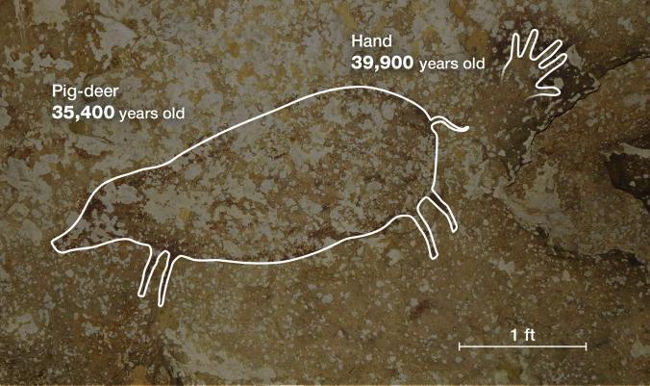
Photo by: M. Aubert/Nature
Cave paintings in the Leang Timpuseng Cave in South Sulawesi, Indonesia, have radically changed the understanding of the earliest human creativity. Recent analysis of the mineral deposits on the images has shown that the oldest hand stencil is nearly 40,000 years old, which means that it predates many of the oldest cave paintings in Europe. This also means that cave art didn’t develop in Europe as formerly believed but rather emerged independently in different parts of the world simultaneously or perhaps even before modern humans left Africa. In the latter case, there could possibly be even much older cave paintings out there awaiting to be discovered.
Kakadu National Park, Australia

Recognized by the UNESCO as a World Heritage Site for its natural and cultural significance in 1981, the Kakadu National Park is also famous for containing one of the highest concentrations of rock art in the world. To date, more than 5,000 sites have been documented, while the most outstanding examples of Aboriginal rock art can be admired at Ubirr, Burrungkuy (Nourlangie) and Nanguluwurr. The oldest Kakadu cave paintings are estimated to be over 20,000 years old and offer a unique insight into thousands of years of history and culture of the Aboriginal people who are believed to have occupied the site as early as 50,000 years ago.
Cave of el Castillo, Spain
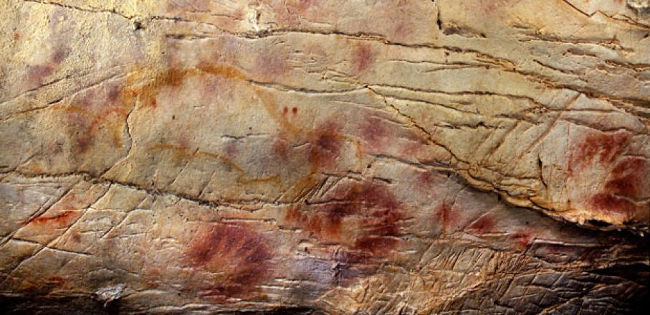
Photo by: Pedro Saura
Located within the complex of Caves of Monte Castillo, the Cave of el Castillo in the Spanish region of Cantabria contains the oldest known cave paintings in Europe. In 2012, an unimpressive red disc was found to be at least 40,800 years old which means that it predates artwork in other European caves for several thousand years. The disc’s age gave rise to speculations that it might have been created by the Neanderthals but there is not enough evidence to either support or reject this possibility. The 2012 study has also shown that the hand stencils around the disc were created between 37,300 and 27,000 years ago.
Nawarla Gabarnmang, Australia
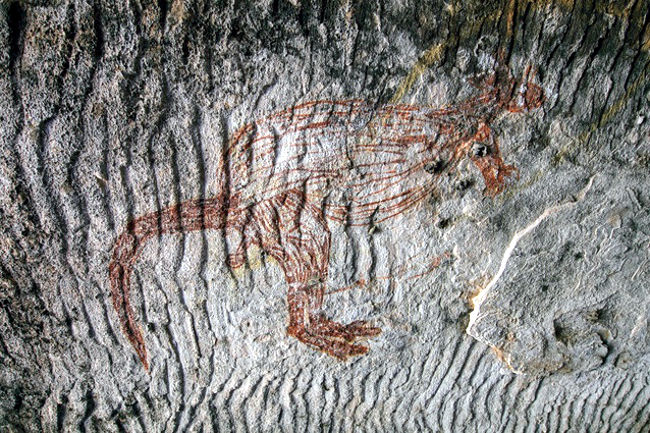
Photo by: John Gollings
Discovered only in 2006, Nawarla Gabarnmang in Australia’s Northern Territory was soon found to contain hundreds of spectacular cave paintings including the oldest cave painting in Australia with a confirmed age. During archaeological excavations following the site’s discovery, archaeologists found a small piece of charcoal-painted rock that fell of from the ceiling and radiocarbon-dated it at 28,000 years old. The discovery of ‘use-worn’ ochre crayons not far from Nawarla Gabarnmang that have been dated at around 50,000 years old, however, suggest that the site may have been decorated with cave paintings even earlier.
Rock Shelters of Bhimbetka, India

Photo by: Bernard Gagnon
Significance of the Rock Shelters of Bhimbetka in the Indian state of Madhya Pradesh was first discovered in the 1950s by the Indian archaeologist V.S. Wakanar who noticed a similarity with prehistoric caves in Europe. But the true significance of Bhimbetka was discovered only by later archaeological excavations - most in the 1970s - which revealed the vast scale of the site that consists of over 700 shelters. Many of these contain cave paintings with themes ranging from animals to various human activities and religious concepts. The oldest paintings have been dated to 30,000 years BP, while the most recent ones originate from the Medieval period.
Lascaux, France

Also known simply as Lascaux, the Lascaux Cave in southeastern France not only contains some of the oldest cave paintings in the world. It also contains some of the most important cave paintings for understanding of prehistoric art. Unfortunately, Lascaux’s 17,000-years-old paintings began to deteriorate rapidly soon after the cave’s discovery in 1940. Large number of visitors dramatically changed the microclimate within the cave which caused a serious damage to the paintings. This prompted the authorities to close Lascaux to the public in the 1960s and later to restrict access even to scientists.
Coliboaia Cave, Romania
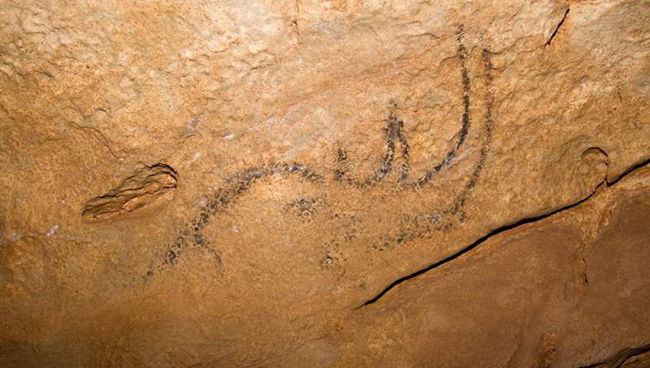
Photo by: Andrei Posmosanu/Romanian Federation of Speleology
Even though the Coliboaia Cave has been known for over a century, its prehistoric cave paintings were discovered only in 2009. Radiocarbon-dated at 32,000 to 35,000 years old, the images of various animals including a horse, bison, rhinoceros and bear are the oldest known cave paintings in this part of Europe. It is thought that there were highly likely more drawings but were probably destroyed by the underground river which often floods the cave. Unfortunately, the surviving cave paintings in the Coliboaia cave are extremely inaccessible as some can be reached only by lying down in the water and keeping the head just above the water.
Apollo 11 Cave, Namibia
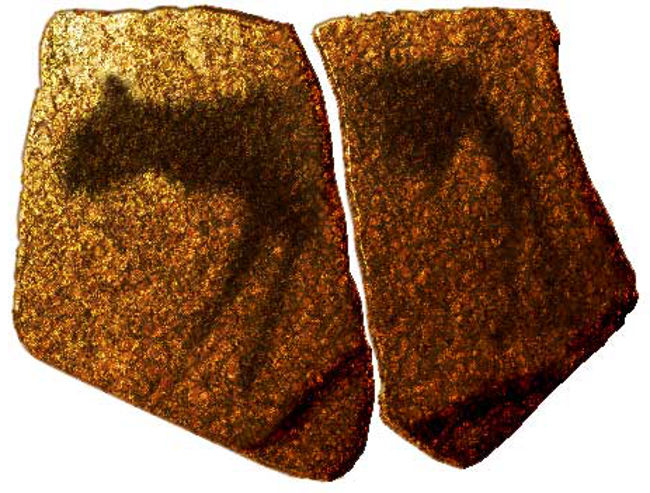
The Apollo 11 Cave in southwest Namibia is best known for containing seven stone slabs with drawings that have been radiocarbon dated to 27,500 to 25,500 years BP. Until recently, they were the oldest known works of art in Africa. The cave, which has been named after Apollo 11 spaceflight because its discovery in 1969 closely coincided with the first manned moon landing, also contains a series of wall paintings and engravings. But these are not as old as the better known stone slabs. While wall paintings are thought to have been created between 10,400 and 6,200 BP, the engravings have been dated to the 1st millennium BP.
Tassili n’Ajjer, Algeria

Cave paintings in the national park of Tassili n’Ajjer in Algeria are estimated to be ‘only’ about 10,000 years old but they are widely regarded to be among the most important collections of prehistoric cave paintings in the world. So far, over 15,000 rock drawings and engravings have been discovered on an area spanning 28,000 square miles. They depict everything from large wild animals (including now-extinct species) to daily life and climatic changes over a period from about 10,000 years ago to the early present era, including the transformation of Sahara from a lush green savannah to the present-day arid desert.
Cumberland Valley Caves, United States
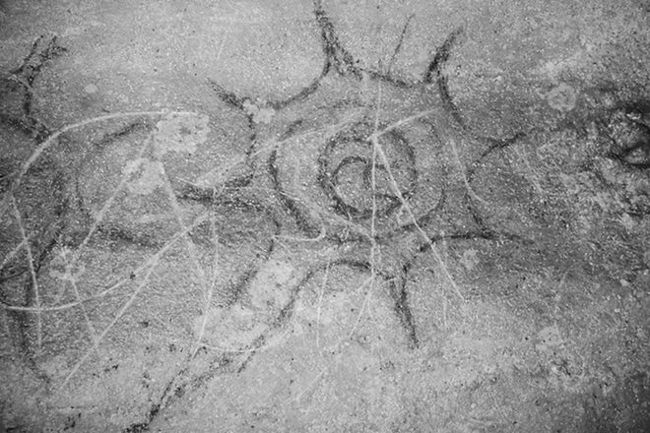
Photo by: Jan Simek et al/Antiquity Publications LTD
Discovered in 2013, the oldest paintings in the Cumberland Valley Caves in Tennessee have been estimated to be about 6,000 years old. Although this is relatively ‘young’ compared to other cave paintings around the world, they represent the oldest known cave art in the United States. More importantly, they provide an invaluable record of how prehistoric peoples in this Appalachian Mountains valley understood the world, universe and the human place in it. However, most cave paintings in the Cumberland Valley are more recent, some are thought to be as recent as the 11th to 17th century.
Serra da Capivara National Park, Brazil

Photo by: Vitor 1234/Wikipedia
Home to one of the most important archaeological sites in the Americas, the Serra da Capivara National Park is also home to some of the oldest cave paintings - not only in the Americas but in the world. With the oldest cave drawings in the park thought to be over 25,000 years old and other discoveries suggesting that the site may have been settled as early as 50,000 years ago, the Serra da Capivara has seriously shaken the traditional theory of human settlement of the Americas. According to the latter, the first human populations arrived to the Americas about 13,000 to 15,000 years ago.
Caves of Arcy-sur-Cure, France

Famous for their spectacular geological formations, the Caves of Arcy-sur-Cure are also famous for their cave paintings which are among the oldest ones in Europe. Radiocarbon dated at up to 29,000 years old, the Caves of Arcy-sur-Cure are home to the second oldest cave paintings in France after those in the Chauvet Cave. Unfortunately, an estimated 80% of the pantings are thought to be destroyed by wall cleaning in the 1970s. At the time, their existence was unknown as they were covered by a thick layer of black smoke from torches. Those that survived the wall cleaning lay hidden under a deep calcite layer until 1990.
Kapova Cave, Russia
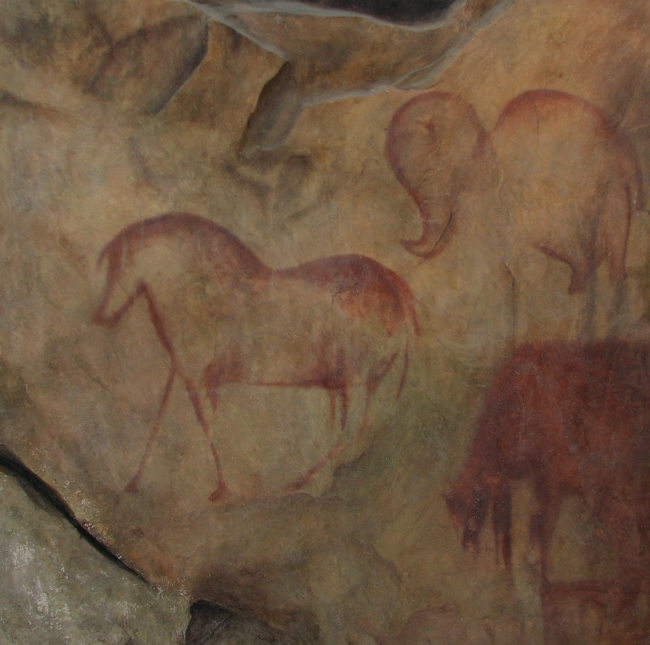
Estimated to be 17,000 years old, the drawings in the Kapova Cave (also known as Shulgan-Tash cave) in the Russian Urals are relatively recent compared to those in Western Europe. Despite that, their discovery in the late 1950s was considered one of the most significant finds for prehistoric cave art. It showed that cave painting wasn’t only limited to Western Europe but took root in Eastern and Central Europe as well. Nearly 200 images have been discovered to date (the majority only recently) and depict different animals such as horses, mammoths, wooly rhinoceroses, humans and very intriguing abstract signs which don’t have any correlation with their Western European counterparts.
References:
Balter, Michael. “Romanian Cave May Boast Central Europe’s Oldest Cave Art.” Science, 21 Jun. 2010, http://www.sciencemag.org/news/2010/06/romanian-cave-may-boast-central-europes-oldest-cave-art.
Cyranoski, David. “World’s oldest art found in Indonesian cave.” Nature, 8 Oct. 2014, https://www.nature.com/news/world-s-oldest-art-found-in-indonesian-cave-1.16100.
David, Bruno et al. “Nawarla Gabarnmang, a 45,180±910 cal BP Site in Jawoyn Country, Southwest Arnhem Land Plateau.” Australian Archaeology, No. 73, Dec. 2011, pp. 73-77.
“Decorate Cave of Pont d’Arc, known as Grotte Chauvet-Pont d’Arc, Ardeche”. UNESCO, https://whc.unesco.org/en/list/1426. Accessed 9 Oct. 2018.
Garcia-Diez, Marcos et al. “The chronology of hand stencils in European Palaeolithic rock art: implications of new U-series results from Castillo Cave (Cantabria, Spain).” Journal of Anthropological Sciences, Vol. 93, 2015, pp. 135-152.
Harrington, Spencer P.M. “Grotto Paintings Revealed.” Archaeology, Vol. 53, No. 3, May/Jun 2000, https://archive.archaeology.org/0005/newsbriefs/grotto.html.
Kramer, Miriam. “Cave Art Reveals Ancient View of Cosmos.” Live Science, 27. June 2013, https://www.livescience.com/37812-cave-art-reveals-ancient-view-of-cosmos.html.
“Lascaux. Discover the cave.” Archeologie.culture.fr, http://archeologie.culture.fr/lascaux/en. Accessed 9 Oct. 2018.
Marchant, Jo. “A Journey to the Oldest Cave Paintings in the World.” Smithsonian Magazine, January 2016, https://www.smithsonianmag.com/history/journey-oldest-cave-paintings-world-180957685/.
Masson, John. “Apollo 11 Cave in Southwest Namibia: Some Observations on the Site and Its Rock Art.” The South African Archaeological Bulletin, Vol. 61, No. 183, Jun. 2006, pp. 76-89.
Museo Nacional Y Centro De Investigacion De Altamira. Ministerio de Cultura y Deporte - Gobierno de Espana. http://www.mecd.gob.es/mnaltamira/en/home.html#. Accessed 9 Oct. 2018.
Pike, Alistair. “Earliest cave paintings were made by Neanderthals.” University of Southampton, 23 Feb. 2018. https://www.southampton.ac.uk/news/2018/02/neanderthals-art.page.
“Prehistoric Sites and Decorate Caves of the Vezere Valley.” UNESCO, https://whc.unesco.org/en/soc/930. Accessed 8 Oct. 2018.
“Rock art.” Kakadu National Park, https://parksaustralia.gov.au/kakadu/do/rock-art/. Accessed 8 Oct. 2018.
“Rock Painting of Shulgan-Tash Cave.” UNESCO, https://whc.unesco.org/en/tentativelists/6309/. Accessed 9 Oct. 2018.
“Rock Shelters of Bhimbetka. Continuity Through Antiquity, Art & Environment.” UNESCO, https://whc.unesco.org/uploads/nominations/925.pdf. Accessed 9 Oct. 2018.
“Serra da Capivara National Park.” UNESCO, https://whc.unesco.org/en/list/606. Accessed 9 Oct. 2018.
“Tassili n’Ajjer.” UNESCO, https://whc.unesco.org/en/list/179. Accessed 8 Oct. 2018.
Vergano, Dan. “Cave Paintings in Indonesia Redraw Picture of Earliest Art.” National Geographic, 8 Oct. 2014, https://news.nationalgeographic.com/news/2014/10/141008-cave-art-sulawesi-hand-science/.
Published on Fri, Nov 16, 2018.